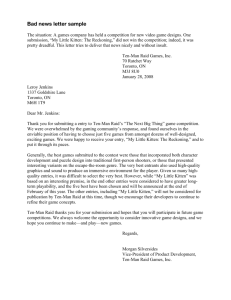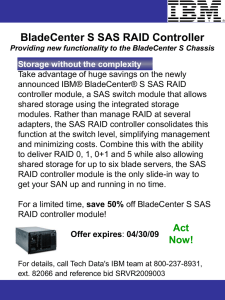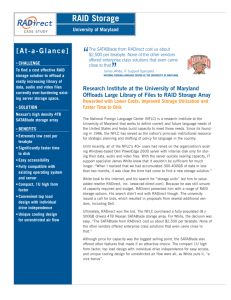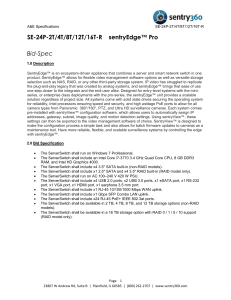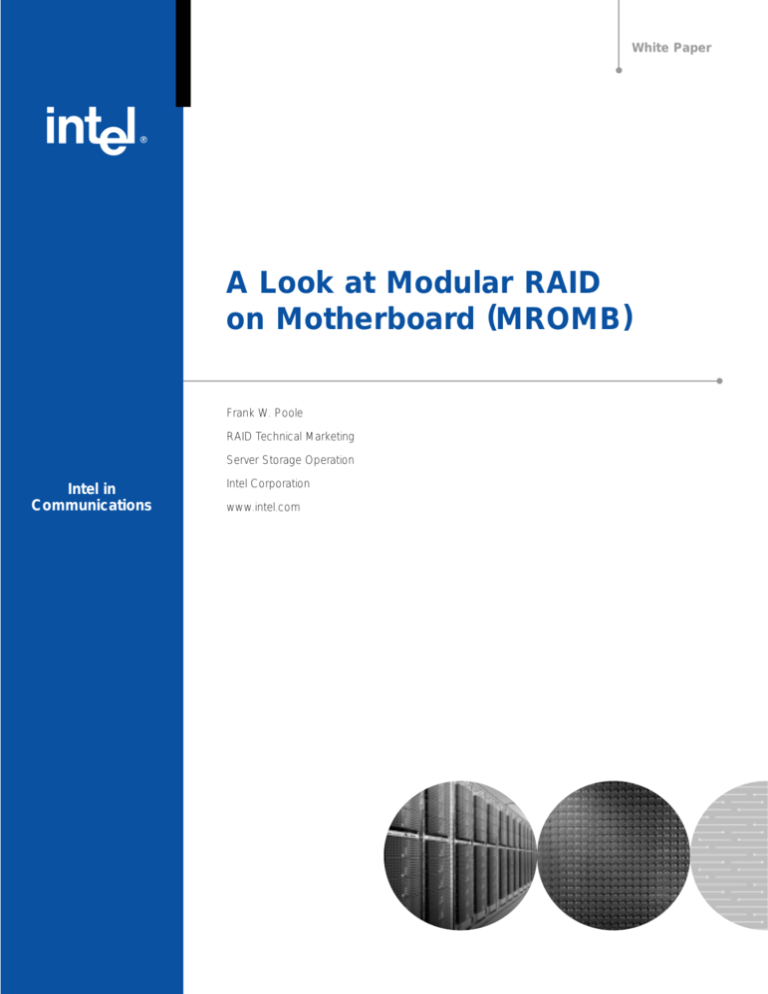
White Paper
A Look at Modular RAID
on Motherboard (MROMB)
Frank W. Poole
RAID Technical Marketing
Server Storage Operation
Intel in
Communications
Intel Corporation
www.intel.com
Contents
Meeting increasing storage demands in smaller physical space
3
Current host-based hardware RAID solutions
3
The evolution of RAID on motherboard solutions
4
Introducing next-generation MROMB solutions
5
MROMB technology overview
5
Target markets
7
Conclusion
7
Author’s biography
7
A Look at Modular RAID on Motherboard (MROMB)
Meeting increasing storage demands
in smaller physical space
The demand for increased storage imposed by today’s
computing requirements is driving searches for new ways
to store and protect stored data in a shrinking rack space
environment. While processor clock rates have grown steadily
over the past twenty years, the need for storage space has
grown substantially and the expense of physical space has
increased, fueling a need for compact, reliable, highly available
and modular storage solutions.
With demand for storage space seriously outpacing demands
for processing power, redundant array of independent disk
(RAID) technology is increasingly used to meet the need for
protected high-density storage space. But though critical data
exists in businesses of every size, RAID technology has not
been deployed indiscriminately, due to cost, complexity and
support issues.
Zero channel RAID (ZCR) or modular RAID on motherboard
(MROMB) is becoming an attractive choice for other equipment
manufacturers (OEMs) looking to implement cost-effective
hardware RAID solutions in high-density servers. A zero-channel
RAID adapter is a peripheral component interconnect (PCI) RAID
controller that doesn’t have any small computer serial interface
(SCSI) channels on board, but is instead designed to use the
on-board SCSI channels of the server motherboard to implement
a cost-effective hardware RAID solution.
Unlike RAID on motherboard (ROMB), which puts all RAID
related components on the motherboard, MROMB offers the
flexibility of a full-featured add-in card with efficient system
resource use, and therefore low cost. The major difference
between a RAID add-in card and an MROMB card is that the
MROMB card lacks a SCSI input/output (I/O) chip. MROMB is
similar to an add-in RAID card in that it is installed in a PCI slot
on the motherboard, but the slot must have been modified to
support a PCI MROMB RAID card. When the MROMB card is
inserted in this special slot, the on-board SCSI channels of the
motherboard become a RAID-enabled subsystem, capable of
almost all the functionality of a full featured, add-in RAID card.
When not occupied by the specially designed RAID add-in
card, the PCI slot can be used as a standard 64-bit 66 MHz
PCI or PCI-X slot.
White Paper
MROMB can also be implemented through a dedicated, small
form factor PCI connector on the motherboard and a creditcard sized RAID card designed to fit it. The low profile form
factor of this solution meets customer needs for physically
smaller servers. But because of the dedicated hardware, this
approach is more expensive for motherboard manufacturers
to apply. It has the advantage of not consuming a PCI slot, a
resource which could be at a premium in low-profile 1U and
2U server systems. As designers increasingly locate most
components (such as video, network interface card (NIC) and
so on) on the motherboard, however, minimizing the use of
PCI resources becomes less of an issue.
Current host-based hardware
RAID solutions
The most common way to add RAID capability to a server is
using a host-based adapter (HBA) RAID card (see Figure 1).
It is also generally the most expensive approach since it duplicates
some components already present on the motherboard, in
particular the SCSI I/O components. It is quite flexible, however,
because the processing power, software and I/O logic are
incorporated on the RAID card.
At the other end of the price spectrum is the ROMB approach.
ROMB is an efficient, cost-effective solution that leverages the
RAID components that are already built into the motherboard.
With the ROMB approach, however, the motherboard
manufacturer is burdened with the expense of implementing
the RAID solution on every motherboard produced, the cost of
which is passed on to the end-user—even if the user never
takes advantage the RAID functionality.
The MROMB approach (see Figure 2) is designed to offer the
best of both worlds. A MROMB implementation provides great
flexibility in equipping a system with RAID, just as the HBA
approach does. By using the onboard SCSI I/O processor built
into the motherboard instead of providing a duplicate SCSI I/O
controller, the MROMB solution can be priced closer to that of
a ROMB solution.
In addition, MROMB controllers provide a compact, low-profile
form factor consistent with the limited space requirements of
1U and 2U high-density servers. The cost to the motherboard
manufacturer for implementing MROMB is generally affordable.
3
White Paper
A Look at Modular RAID on Motherboard (MROMB)
Mo
t
he
rb
oa
rd
Pr RAID
oc
es I/O
so
r
Pr SC
oc S
es I
so
r
Figure 1. Typical add-in HBA RAID solution can be installed
in any available PCI slot.
The evolution of RAID
on motherboard solutions
Various problems were associated with these early solutions,
however. For example:
Incorporating a zero channel RAID on motherboard solution
is not entirely new. All major RAID vendors have explored
proprietary solutions.
• Some operating system installations install unnecessary
Beginning in 1998 and 1999, several product families were
introduced that used innovative technologies on the
motherboard to create RAID solutions. While implementation
details differed, these solutions were based on the same
fundamental concepts, which were:
• Build a PCI RAID card around an I/O processor, such as the
Intel® i960® Rx reduced instruction set computing (RISC) chip.
• De-populate the SCSI I/O processor and connectors.
• Incorporate special interrupt logic that steers the host I/O
generic I/O drivers that try to control the device and produce
driver conflicts when the generic driver and the RAID controller
firmware try to access the same device.
• Optional ROMs on other add-in cards from the same
manufacturer could interfere with the operation of the add-in
RAID card.
• The initialization device select (IDSEL) signal, which identifies
devices on the PCI bus, can be left uncontrolled on the host
system I/O device.
The IDSEL problem is the most common, and is aggravated
by the fact that a standardized way to control IDSEL has not
interrupts to a pre-assigned system PCI RAID or proprietary
been developed for the different chipsets used by motherboard
slot, which in turn delivers control of the onboard motherboard
design engineers and manufacturers. Up to now, it has been
SCSI chips to the RAID controller.
up to the host BIOS to accommodate each variation and
implement each new implementation. This lack of standardization
has inhibited the development of a consistent core host BIOS
across different platforms and limited the deployment of
MROMB solutions in general.
4
A Look at Modular RAID on Motherboard (MROMB)
Mo
t
he
White Paper
rb
oa
rd
S
Pr CS
oc I
es
so
r
De
d
Sloicate
t d
Pr RAID
oc
es I/O
so
r
Figure 2. MROMB add-in solution.
Introducing next-generation
MROMB solutions
New ways of implementing MROMB technology have
recently emerged.
Intel and Adaptec, Inc. have both introduced inexpensive,
modular RAID technologies designed to allow OEMs to deploy
RAID technology on mid-range server boards.
The Intel solution is RAID I/O steering, or RAIDIOS, which is
designed to take advantage of MROMB solutions, such as
the Intel® SRCMRU Zero Channel RAID card powered by the
Intel® IOP303 RISC-based I/O processor. The Intel® IOP303 I/O
processor is an open architecture, proven I/O processor used
in many OEM RAID solutions. RAIDIOS allows two channels
of onboard I/O SCSI to be used. Intel RAIDIOS logic circuitry
can currently be found on such boards as the Intel® SCB2,
SuperMicro* P4DP6 and other platforms. In fact, RAIDIOS
has been adopted by most server board manufacturers
implementing a PCI based ZCR solution.
Embedded RAID logic, or EMRL*, from Adaptec is specifically
designed to be used with Adaptec Zero Channel RAID cards
that contain the recently introduced Adaptec AIC* 7930W
RAID I/O processor. EMRL requires more discrete logic on the
motherboard than the Intel solution, a cost that has to be
absorbed by the motherboard manufacturer. EMRL’s dependence
on a proprietary processor and need for discrete logic support
components limit this approach’s flexibility.
Adaptec has two such ZCR cards with different form factors
shipping currently. One is a credit-card sized device that requires
a special connector be placed on the motherboard instead of
using an existing PCI slot, so it can be used for other purposes.
The other is a standard PCI format card which can take
advantage of EMRL or RAIDIOS.
MROMB technology overview
In a typical implementation of an attached PCI I/O device, such
as an onboard SCSI controller, interrupt signals are routed to
the host system’s interrupt controller. When the device requires
service from its host driver, the interrupt is received by the host
interrupt controller and serviced accordingly.
Implementing RAID using the onboard SCSI device requires
that I/O signals generated by the host be intercepted when they
are issued. Once a signal is intercepted, it is passed to the
RAID circuitry for processing and the requested data is then
passed over to the I/O channel. To accomplish this, interrupt
5
White Paper
A Look at Modular RAID on Motherboard (MROMB)
signals directed to the onboard SCSI controller are rerouted
to the special MROMB assigned PCI slot when the zero
channel device is present using one of the MROMB technologies
(see Figure 3).
The dissimilar processes that the PCI or PCI-X 133 devices
and MROMB use for handling host communication use produce
timing differences, which lead to divergences in the operation
of the RAIDIOS and EMRL implementation schemes.
When the system is booted, the host BIOS scans the PCI bus
to locate all attached PCI devices. The IDSEL signal is used by
the system to identify all I/O devices it finds and assign the
needed resources to them.
Intel RAIDIOS compensates for timing differences by placing
the control logic on the MROMB card. EMRL, on the other
hand, requires that discrete logic compensating for the timing
differences be installed on the motherboard. EMRL therefore
requires design changes on the motherboard to make it work
for PCI-X while RAIDIOS requires no such changes.
When a ZCR adapter is present in its MROMB-enabled PCI
slot, it takes control of the IDSEL signal and performs its own
configuration cycles to the onboard SCSI I/O controller. This
has the effect of hiding it from the host during its configuration
cycles. Once the SCSI is hidden and the MROMB adapter
controls the bus, it uses its MROMB controller logic to ensure
that IDSEL for the SCSI devices are controlled by the
MROMB card. This makes sure the host system never sees
the SCSI devices and the MROMB card has full control and
can now provide RAID functionality using the onboard SCSI
I/O processor(s).
PC
H
Br OS
idg T
e
O
PC Ad the
I D d-i r
ev n
ice
IS
I/O
Int
er
fac
Em
I/O be
e
Co (S dd
nt C ed
ro SI
lle )
r
lot
MR
HO
ST
SD
OM
Sy
B
Te
c
ste
m
hn
olo
PC
us
Figure 3. Typical MROMB system architecture.
RA
M
Pr I/
oc O
es
so
gy
PC
IB
6
In either case, when the system is rebooted, the user is presented
with the RAID controller setup BIOS screen instead of the
standard onboard SCSI screen. By pressing a pre-defined
hot-key combination, the user can access the processes for
setting up the attached SCSI hard drives into a hardware
RAID configuration, just as would be done for an HBA add-in
RAID controller.
IS
lot
MR
OM
B
Fla
r
Ca
sh
rd
RA
M
A Look at Modular RAID on Motherboard (MROMB)
White Paper
Target markets
MROMB technology is of great interest to customers currently
hampered by short supply of storage space and seeking
high-density servers. This customer base includes, but is not
limited to, Internet service providers (ISPs), application service
providers (ASPs), storage service providers (SSPs) and other
storage-hungry customers. These industry providers typically
need the ability to quickly add processing power and require
enormous amounts of protected storage.
Conclusion
The demand for denser, less expensive, higher performing
storage solutions is leading to the deployment of MROMB
technology on more and more motherboards.
MROMB cards are less expensive and generally smaller than
add-in single and dual-channel host-based RAID solutions
because they don’t duplicate components, such as SCSI I/O,
found on the motherboard. They provide advanced RAID
performance similar to an add-in RAID card.
MROMB add-in cards do however require IDSEL interrupt logic,
such as Intel RAIDIOS or Adaptec EMRL, to be present on the
motherboard. While both technologies are relatively inexpensive
for motherboard manufacturers to implement, the Intel solution
offers greater flexibility. MROMB also combines the best of
host-based RAID and ROMB solutions by providing the flexibility
to upgrade at low cost without burdening motherboard makers
with unnecessary expense.
Author’s biography
Frank Poole is a RAID Technical Marketing Engineer for the
Storage Components Division, Intel Corporation. Frank is
responsible for assisting engineering in identifying and defining
market opportunities and product development in SCSI, SATA
and Fibre Channel storage as well as providing pre and post
sales support to major OEM and ODM customers. Frank has
over 6 years experience in server storage and comes to Intel
through the 2001 acquisition of RAID industry innovator ICP
vortex Computersysteme GmbH, Neckarsulm, Germany.
7
White Paper
A Look at Modular RAID on Motherboard (MROMB)
For more information, visit the Intel web site at:
http://developer.intel.com/design/storage
Intel may make changes to specifications and product descriptions at any time, without notice.
*Other names and brands may be claimed as the property of others.
Intel, and the Intel logo are trademarks or registered trademarks of Intel Corporation or its subsidiaries in the United States and other countries.
Information in this document is provided in connection with Intel® products. No license, express or implied, by estoppel or otherwise, to any intellectual
property rights is granted by this document. Except as provided in Intel’s Terms and Conditions of Sale such products, Intel assumes no liability
whatsoever, and Intel disclaims any express or implied warranty, relating to sale and/or use of Intel products including liability or warranties relating to
fitness for a particular purpose, merchantability, or infringement of any patent, copyright or other intellectual property right. Intel products are not
intended for use in medical, life-saving, or life-sustaining applications. Intel may make changes to specifications and product descriptions at any time,
without notice.
Copyright © 2002 Intel Corporation. All rights reserved. 0902/ASI/AVM/MTL/IW/1K
C Please Recycle
251575-001

